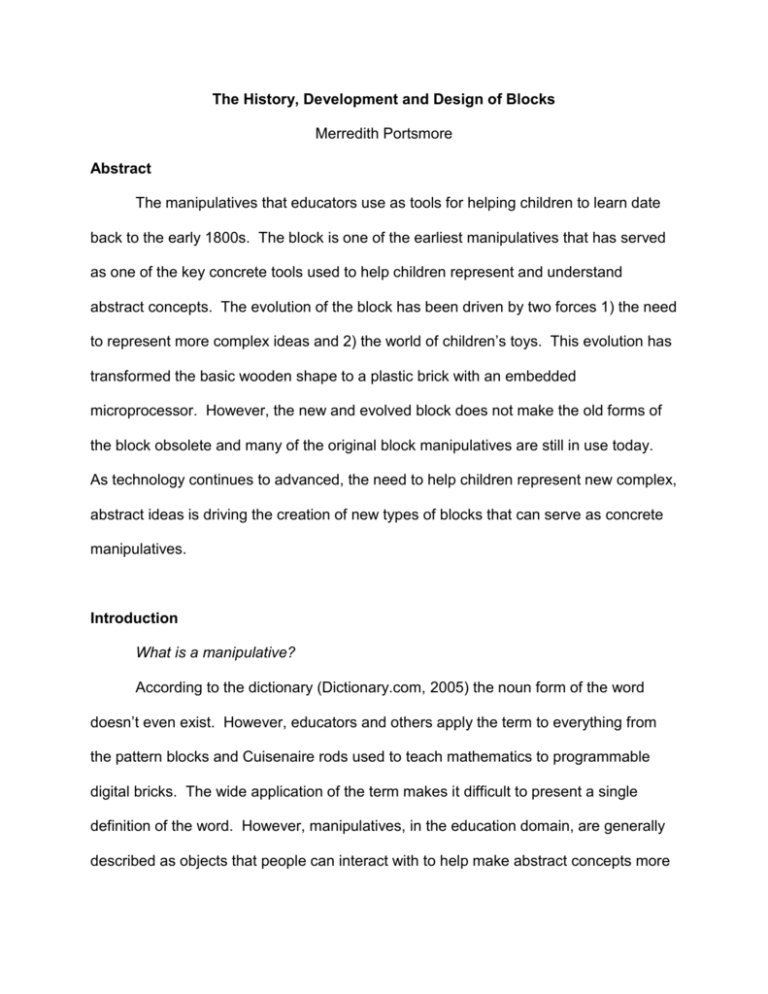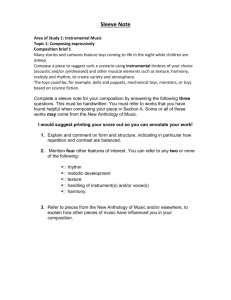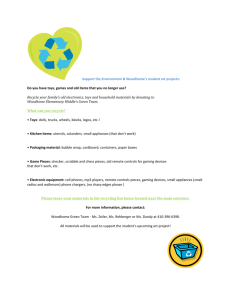Manipulatives in Education: Wooden Play toys to Digital Educational
advertisement

The History, Development and Design of Blocks Merredith Portsmore Abstract The manipulatives that educators use as tools for helping children to learn date back to the early 1800s. The block is one of the earliest manipulatives that has served as one of the key concrete tools used to help children represent and understand abstract concepts. The evolution of the block has been driven by two forces 1) the need to represent more complex ideas and 2) the world of children’s toys. This evolution has transformed the basic wooden shape to a plastic brick with an embedded microprocessor. However, the new and evolved block does not make the old forms of the block obsolete and many of the original block manipulatives are still in use today. As technology continues to advanced, the need to help children represent new complex, abstract ideas is driving the creation of new types of blocks that can serve as concrete manipulatives. Introduction What is a manipulative? According to the dictionary (Dictionary.com, 2005) the noun form of the word doesn’t even exist. However, educators and others apply the term to everything from the pattern blocks and Cuisenaire rods used to teach mathematics to programmable digital bricks. The wide application of the term makes it difficult to present a single definition of the word. However, manipulatives, in the education domain, are generally described as objects that people can interact with to help make abstract concepts more concrete. To date there are many objects that could be considered manipulatives (clay, sticks, paper), however this paper focuses on the evolution of the basic block from wooden toy to plastic bricks with embedded microprocessors. Are blocks considered an educational technology? The latest and greatest manipulatives that include batteries and microprocessors obviously have the trappings of what is considered technology. However, what about the simple blocks and bricks that populate many classrooms? If we define technology as “the science of the application of knowledge to practical purposes” (Dictionary.com, 2005) we see that these materials reflect educators application of knowledge to helping students to gain greater knowledge and understanding. Where did blocks come from? One would think that building or construction toys would be one of the earliest forms of toys. While this may be true, there is little evidence to support it. Historical research on toys indicates that children appear to have toys in all cultures dating back to the early BC era. However only items like carved animals or figures that were made from materials like ivory or jade. This may be because building toys were created from more perishable materials like wood or sand. The first definitive indications of the toys we would recognize today as blocks appear in a few 15th and 16th century paintings of children and families. However, blocks and other toys did not become widely available until the 17th and 18th century. These centuries brought a new attitude towards children, not as miniature adults, but as developing beings. Hence, play was of more value and this era saw the development of more toys for children and the emergence of some of the first concrete manipulatives (alphabet blocks). (Read, 1992). The change in attitudes toward children coincided with the Industrial Revolution (1760 to 1840) and toy manufacturers emerged as the demand for toys increased. A great deal of the initial toy manufacturing was concentrated in Germany where industrialization of toy production was able to bring down the cost of the previously handmade toys. (toys, 2005). In the early 1800’s the first building blocks, produced by a German company, appeared. Complete with arches, doorways, and columns, the sets were designed for building specific structures and left little room for imagination (Read, 1992). However, they did pave the way for more toys and for educators to begin to contemplate their use as a learning tool. Froebel: The beginning of blocks and education With a thriving toy industry in his backyard producing an array of products, German Friedrich Froebel was the first educator to seriously contemplate how these objects like blocks could be used in the education of young people. While there had been a few essays and efforts prior to Froebel, his efforts were the most systematic and had the most lasting effects (Hayward, 1979). Froebel is credited with being the “inventor” of kindergarten, which was the first educational experience available for children under age 7 at the time (Brosterman, 1997). Froebel was heavily influence by the pedagogy of Johann Pestalozzi, who advocated hands-on, active education. Froebel, in turn, focused kindergarten on movement, creation, curiosity, and play in contrast to the memorization and content driven nature of school. To help children gain concepts of space, patterns, shapes, and more Froebel selected 20 “gifts”. These gifts consisted (Figures 1 & 2) of manipulative ranging from balls, blocks, and sticks to clay, drawing supplies, and weaving materials. Some of the gifts were designed by him and others were preexisting materials. All were intended to be used by children through active play (Brosterman, 1997) rather than rigorous adult supervision and direction (Read, 1992). Figure 1: Gift 1 (left) the balls with string and Gift 2 (Right) the cubes, spheres, cylinder and sticks (http://www.froebelgifts.com) Figure 2: Gift 3 (1”cubes) (left) and Gift 7 (shape tiles) (right) Froebel’s blocks (Gifts 3-6) serve as the foundation for blocks as an educational tool. The blocks in his gifts were of specific dimensions with the idea that students would find relationships by using them. Gift 3 for example consisted of eight 1” cubes that could be combined to form a 2”x2”x2” cube as well as other shapes. With Froebel and his trained teachers as advocates, kindergarten, and therefore the gifts, exploded in popularity in Germany and abroad. Several great 20 th century minds (namely architect Frank Lloyd Wright and Albert Einstein) participated in a version of Froebel’s kindergarten system and attributed some of their success to the system. Frank Lloyd Wright stated in his autobiography “The maple-wood blocks...are in my fingers to this day," (Wright, 2005) Froebel had a carefully constructed method of training kindergarten teachers to present the gifts in a prescribed method. However, how the gifts were used that was altered as kindergarten was disseminated throughout the world. In the U.S, Milton Bradley and his family were among the first to adopt kindergarten. In addition to starting a kindergarten, Bradley’s company began manufacturing the gifts but with a diluted sense of their original purpose. The gifts meaning and use was tailored to capture the attention of a newly immigrated population seeking to become better citizens. Moreover, Milton Bradley also began manufacturing other block products that were similar to the gifts but without the educational goals and thoughtfulness of Froebel’s gifts to capitalize on the popularity of kindergarten products. (Brosterman, 1997). How much can you change about a block?: Montessori and more Froebel and his gifts sparked excitement and change and by the early 1900s several other educators were creating their own versions of kindergarten that that integrated manipulatives – particularly blocks. Maria Montessori took a similar approach to Froebel with using manipulatives as an integral part of learning. She created her own set of blocks, similar to geometric that students were to use to complete specific tasks (create a set of stairs or a tower of specified height and width). (Montessori, 1912; Read, 1992) Montessori’s method was much more structured than Froebel’s with less emphasis on play and more emphasis on “spontaneous” discovery of a specific outcome. Similar to Froebel, Montessori designed blocks that had specific mathematical properties (Figure 3) and tasked students to arrange them in particular ways. Figure 3: A child playing with blocks designed by Maria Montessori (the slotted cylinder Blocks continued to be redesigned as educators incorporated them into their educational methods. Patty Smith Hill, from Louisville, Kentucky, responded to Froebel’s method and the materials. She further redesigned Froebel’s blocks by making them much larger so students could build very sizable structures (Read, 1992) Hill imbued her implementation of kindergarten with a more Deweyan approach and wanted students to be able to interact in everyday tasks and form a community. Hence, she wanted blocks that could create structures large enough for students to walk under or play in. (Rudnitski, 1995) Another American educator Caroline Pratt was more interested in the mathematic principles and construction principles inherent in blocks. Pratt expanded on Froebel’s concept of mathematical relationships of blocks by creating more types of blocks and presenting them to children as a single set of materials rather than in small packages. The outcome of her work is the unit blocks (Figure 4) found in nearly every kindergarten and preschool classroom. (Read, 1992) Figure 4: The current unit blocks found in many classrooms were originally developed by Caroline Pratt In the early 1950’s Belgium School teacher Georges Cuisenaire created his own modification of the Froebel’s blocks furthering the concept of mathematics. His blocks were composed of individual units (1 cm per unit) with colors representing different lengths (Figure 5). (Gattegno-Cuisenaire, 2005). Cuisenaire worked with a Dr. Caleb Gattegno, a mathematics educator, to refine and promote what would be come to be know as “Cuisenaire Rods” to help bring math to primary and secondary school students. (The Froebel Web, 2005) Cuisenaire Rods completely departed from blocks as a building toy and used them strictly as manipulative for representing abstract math concepts of arithmetic to young children. Figure 5: Cuisenaire Rods range from 1 to 10 units long with each color corresponding to a different lengths From the current literature on mathematics learning, we see that the versions of unit blocks, pattern blocks, and Cuisenaire rods are still used in the K-5 classrooms (Ericson & Niess, 1996). Research on the use mathematics manipulatives continues to show that students achieve better with lessons that use manipulatives than those that do not (Sudyham et all, 1977; Driscoll, 1981). However, many researchers emphasize that proper teacher education is key to the implementation and success of manipulatives (Moch, 2001). More Building Toys: Erector, Meccano, Tinker Toys, and Lincoln Logs While educators in kindergarten refined blocks, the inventors and entrepreneurs of the early 1900s (Table 1) were developing a number of toys that would become the next generation of building toys. It is with these toys that we see more of an emphasis on the realism of the end product and less on the mathematical properties of the materials. Toy Meccano Tinker Toys Year 1906 1910 Inventor Frank Hornby Charles Pajeau and Robert Petit Erector Sets 1911 A.C. Gilbert Lincoln Logs 1924 John Lloyd Wright Table 1: Early Building & Construction Toys (The National Toy Hall of Fame, 2005) The Meccano and Erector companies capitalized on the rapid growth of real world engineering projects in the early 1900s by providing kits and pieces that allowed children to build realistic models of actual buildings and machines (Figure 6 ). The metal pieces in both toys mimicked real building and engineering materials (steel beams, pulleys, and gears). Erector also became the first construction toy to incorporate a motor, giving children the power to add motion to their creations. (Petroski, 1998) Figure 6: Meccano (left) was the first to market while Erector (right) followed, complete with an electric motor. Lincoln Logs arrived on the market just after Meccano and Erector in 1924. The wooden construction toy that mimicked real log construction were the brain child of John Lloyd Wright, son of architect Frank Lloyd Wright. Wright came up with the concept while watching the construction of one of his father’s buildings. Lincoln Logs (Figure 7) has a strong theme associated with them of the American West – implying that by users would have a frontier experience. The set mixed specialty pieces (like roof tiles and doors) with log “primitives” of basic lengths. All three sets of toys came with specific directions on how to build models. However, the 3 companies, particularly Meccano and Erector, acknowledged and supported other creations with their products through magazines with new ideas and design contents. Figure 7: Lincoln Logs sets centered around the theme of the American Frontier. While Meccano, Erector, and Lincoln Logs, allowed for very literal constructions, Tinkertoys, on the other hand, were much more free form. They were developed after inventors Pajeau and Petit watched “children create endless abstract shapes with sticks, pencils, and old spools of thread” (The National Toy Hall of Fame, 2005). From that experience, the two worked to develop a system that would allow for the rods and sticks to combine in an infinite number of ways. Tinkertoys (Figure 8) extended the abstract building concept with new shapes, objects, and connections. Tinkertoys originally had no plans for models but allowed complete free form building. However, as the toy evolved model plans were included so that buyers could build the spectacular structures that were used in advertisements more easily. Figure 8: Tinkertoys gave children toys to extend their existing play. Meccano, Erector, Tinkertoys and Lincoln Logs were not designed to be part of formal educational settings. Nor, for the most part, were they adopted into educational settings as a part of the official instruction. Hence, there is little information available on what type of impact these toys may have had on their users. Though, it could be surmised that they influenced spatial and problem solving skills. However, present day engineers cite these types of toys as integral to their choice career of engineering as well as providing formidable lessons in engineering and design. “Children who played with cans and boxes and Meccano and Erector sets and grew up to be engineers have seldom forgotten those early experiences. The lessons they learned about how things stand up and how they fall down, about how order is superior to chaos, and about how careful planning is as important as good design – all lesson gathered from childhood construction toys – have made them better engineers.” (Petroski, 1998) Despite, the innovation and their initial success only Tinker Toys and Lincoln Logs remain a significant presence on toy shelves today. Meccano has a small presence in parts of Europe while Erector went out of business in the 1980s and has been recently revived on a smaller scale. Models and Building Toys In 1932, a Danish carpenter, Ole Kirk Christiansen, started a toy company (LEGO) which made wooden toys and blocks for several years. However in 1949 the company started to experiment with first plastic making machine. This yielded “Automatic Binding Bricks” which are the predecessors of the LEGO bricks we know today. The official LEGO brick appears in 1953 and during the first decade of its existence, the LEGO company sold a combination of models and free building brick/block sets – effectively addressing the Erector and Tinkertoy/Block market. (LEGO Company, 2005). Similar to other construction toys, the primary sales were as toys play at home. However, LEGO maintained the tradition of Froebel and Caroline Pratt in their design of their components by having the basic building pieces maintained specific mathematical relationships (3 plates make up a brick). (Martin, 1995). Hence, LEGO effectively became the first material to incorporate the educational traditions of Froebel with the building toy concepts of the early model kits (Erector, Meccano etc…) In the early 1960’s the company sold a few sets for schools (Terapi I, II and III) but didn’t make any significant educational efforts until 1982 when it establishes the LEGO Educational Division (also called LEGO Dacta). Motivations for the creation of the division, according to a former R& D Director, include: “1. Sampling effect.- When you see/experience the product in daycare/schools it can influence the "Christmas wish list" 2. Keeping the competition out. - If they don't use LEGO products - they will use something else 3. Business opportunity - another way to make money for the company.” (Rasmussen, electronic mail, April 1, 2005) As a business they were primarily interested in education to generate interest in their product for their retail division and to generate additional funds as a new venture. The Educational Division did however, have it’s own Research & Design group which started to address the issue of combining computers and manipulatives. In 1986, LEGO released its first interface (Figure 9) that allows structures that employ LEGO materials, electric motors and sensors to be controlled by the computer. Figure 9: Interface A is LEGO’s first attempt to combine LEGO bricks with the computer LEGO revises the concept working to implement more sensors and a better connecting between the motors and more sensors. The revised Interface B (better known as Control Lab) was widely released in 1993. Both interfaces connected to the computer by serial cable which keeps constructions from traveling too far from the computer. Figure 10: Interface B features more inputs and outputs and supports the four newly designed LEGO Sensors (light, temperature, rotation, and touch) The LEGO Education Division experienced moderate success with their products selling to educators who were interested in design and basic physics concepts (simple machines, energy). Their kits are similar to the Erector kits with real world plastic pieces (gears, pulleys) and extensive building directions. (LEGO Company, 2005) The most significant investment LEGO, as a company, made in education and in research and development is their partnership with Seymour Papert and MIT’s Media Lab (starting in 1985 and continuing to today). LEGO funds professorships and graduate students at the Media Lab and therefore has the right to license technology and ideas the lab produces. In the mid 90s, Mitch Resnick, Fred Martin, Randy Sargent, and Brian Silverman were interested in concepts of embedded computing (placing computers inside the LEGO bricks) (Resnick et al, 1996) and developed the Programmable Brick (Figure 11). MIT’s Programmable Brick can be considered the first digital manipulative – a manipulative with embedded electronic capabilities beyond its physical attributes. Figure 11: The MIT version of the programmable LEGO brick featured expandable ports and rechargeable batteries (MIT Programmable Brick, 2005) The Programmable Brick allows users to transfer programs from the computer to the brick to run motors and sensors. The brick is not tethered to the computers and allows for autonomous creations. The Programmable Brick, as a digital manipulative, allows users to explore complex concepts. Where blocks allow for mathematical concepts, building toys for how things work, the Programmable Brick allows for concepts of control, feedback, and artificial intelligence, LEGO exercised their licensing option and re-engineered the Programmable Brick for sale on the retail market. Features in MIT’s design, like rechargeable batteries and expandable ports, were removed for cost and to meet retail toy standards of safety. LEGO’s version, the RCX (Figure 12), debuts in September 1998 to rave reviews and becomes a best selling product (Knudsen, 2000). Figure 12: The LEGO RCX features 3 inputs, 3 outputs and an IR interface for communicating with other RCXs. The RCX product has unparalleled success in the educational division where it is adopted in more than 20 countries, a number of which had little previous interest in educational LEGO products. Qualitative descriptions of programs using LEGOs for actual classroom use (Portsmore et al, 2001, Murray & Bartelmay, 2005) describe a range of use from math and science (primarily physics) to engineering, robotics and computer programming. The research examining the effectiveness of these manipulatives is mixed with some studies showing students have increased content knowledge and problem solving abilities and other showing no difference between traditional instruction and those involving digital manipulatives like LEGOs (Wagner, 1999). However, the research methods employed (controlled groups in relatively short time periods) may not be appropriate for assessing the effectiveness of the materials. Cutting Edge Tools and Manipulatives: Blocks continue to evolve as technology enables size, shape, color, and computational capacities to change. MIT’s Media Lab is continuing with the concept of digital manipulatives looking to add computation in more effective and different ways. While the RCX offers students the opportunity to manipulate computation in a form that is easy for them to work with it remains an external device primarily used for constructing LEGO creations that stand alone in the world. However, The Cricket, is a much smaller microprocessor based device that can be more easily integrated into the outside world. This allows students to manipulate their actual environment by creating devices that can control their environment or collect information from it. (Resnick et al, 1998) -- effectively empowering them to make a manipulative out of almost anything. Figure 13: (left) The Cricket is about the size of a 9V battery allowing it to be integrated into projects like windshield wipers for your glasses (right) The Systems Blocks project at the Media Lab is another new way of thinking about digital manipulatives. Pattern blocks and Cuisenaire rods help make abstract mathematical concepts concrete. However, in our increasingly technological world there are new abstract concepts to be explored like algorithms and data flow. System blocks allow users to create a concrete representation of the flow of information and use different types of blocks to alter its state and direction. (Zuckerman & Resnick, 2003) Figure 14: Pattern blocks show the flow (direction and speed) of information through an arrangement of blocks. Challenges and Gaps: In examining the history of blocks, I see a strong and accepted connection between basic blocks and mathematical learning, particularly in the early grades. That same connection does not appear to exist between the more advanced manipulatives like LEGO and the RCX. The research community has yet to establish the measures that effectively assess what they hope these newer blocks help to achieve and the educational community, as a whole, does not seem vested in their use as an integral part of education. While amazing projects like System Blocks emerge, education still seems to be struggling to use manipulatives beyond the early grades. A question posed by a parent in a mathematics educators magazine reflects this disconnect - “I know that my child needed blocks and other objects to help her learn to count and understand math in the early grades but does he still need those things in middle school?” (Martnie, 1994) The acceptance of manipulatives (blocks) at the older grades and in forms other than the derivatives of Froebel’s gifts seems to be an obstacle that I intuitively feel needs to be overcome. The use of LEGO-type manipulatives offers the opportunity for meaningful learning and the development of higher order thinking and learning skills. However, high stakes testing and federal legislation like No Child Left Behind don’t offer means to facilitate this acceptance. The key to altering this content only mentality seems to be to look to industry to demand skills and quality beyond pure content. As it is members of industry who reflect most fondly on the toys that influence their knowledge and careers (Petroski, 1998). Conclusions: When you research the history of many technologies, cars or computers, you see that the latest technology is an outgrowth of the old inventions. The old inventions may employ the same principles but they are not as useful as the newest inventions. The same is not true for blocks and manipulatives -- perhaps because certain elements of the knowledge we value, like adding and subtracting, are far more timeless and fixed that fuel efficiency or processor speed. However, what are considered important understandings is evolving and changing as technology and engineering alter the world. New manipulatives are being added to the toolset of educators to address those issues by a select few. The future looks bright for the continual creation of manipulatives to address new issues despite the difficulty in the actual adoption and assessment of these new blocks. References: Brosterman, N. (1997). Inventing Kindergarten. New York: Harry N. Adams Inc. Dictionary.com (2005) Retrieved March 31, 2005 from http://dictionary.reference.com/ Driscoll, M. (1981) Research within Reach: Elementary School Mathematics. Reston, Va.: National Council of Teachers of Mathematics. Erickson, D & Niess, M. (1996) Focusing on NCTM’s Standards: Teachers’ Choices and Decisions Related to Student Achievement in Middle School Mathematics. Research In Middle Level Education Quarterly. 19 (1996): 23-42. The Froebel Web (2005) Retrieved March 31, 2005 from http://www.froebelweb.org/web2026.html Gattegno-Cuisenaire. Britannica Student Encyclopedia. Retrieved April 6, 2005, from Encyclopedia Britannica Online. <http://80-www-search-eb-com.ezproxy.library.tufts.edu/ebi/article?tocId=9324354> Hayward, F.H.. (1979) The educational ideas of Pestalozzi and Froebel. Westport, Conn.: Greenwood Press. Knudsen, J. (2000) LEGO Mindstorms: An Introduction. Retrieved March 28, 2005 from http://www.oreillynet.com/pub/a/network/2000/01/31/mindstorms/index.html LEGO Company Corporate Information (2005) Retrieved March 31, 2005 from http://www.lego.com/eng/info/ Martin, F., (1995) The Art of LEGO Design (PDF). The Robotics Practitioner: The Journal for Robot Builders, volume 1, number 2, Spring 1995. Moch, P.L., (2001) Manipulatives Work! The Educational Forum. Vol 66 Fall 2001. MIT Programmable Brick (2005) Retrieved March 29, 2005 from http://lcs.www.media.mit.edu/groups/el/projects/programmable-brick/ Montessori, M. (1912). The Montessori Method. New York: Frederick Stokes Co. Murray, J. & Bartelmay, K. (2005) Inventors in the Making. Science & Children (Pending Publication) The National Toy Hall of Fame (2005) Retrieved March 31, 2005 from http://www.strongmuseum.org/NTHoF/ Petroski, H. (1998). The Toys That Built America. Invention & Technology Spring 1998 (40-44) Portsmore, M. ,Kearns, S.A., Rogers, C.M., Barsosky, J., Rogers, C.B., (2001) Successful methods for introducing engineering into the first grade classroom. Proceedings of the American Society of Engineering Education Annual Exposition and Conference, New Mexico, June 2001 Rasmussen, R. (Robert@tuscanex.com) (2005, April 1). Dacta History. E-mail to M. Portsmore (mportsmo@tufts.edu) Read, J. (1992). A Short History of Children’s Building Blocks. In Pat Gura (Ed.), Exploring learning: Young children and blockplay. London: Paul Chapman Publishing Ltd. Resnick, M. Martin, F.G., Sargent, R., & Silverman, B., (1996) Programmable bricks: Toys to Think With. IBM Systems Journal, 35,(3&4), 443-452. Resnick, M., Martin, F., Berg, R., Borovoy, R., Colella, V., Kramer, K., and Silverman, B. (1998). Digital Manipulatives. Proceedings of the CHI '98 conference, Los Angeles, April 1998. Rudnitski, R. A. (1995). Patty Smith Hill, gifted early childhood educator of the progressive era. Roeper Review 18(1): 19–24. Sudyham, M.N., Higgins, J.L., (1977) Activity Based Learning in Elementary School Mathematics: Recommendations from Research. Columbus. Ohio: ERIC/SMEAC toys. Britannica Student Encyclopedia. (2005) Retrieved April 1, 2005, from Encyclopedia Britannica Premium Service. http://www.britannica.com/ebi/article?tocId=209012 Wagner, S. (1999) Robotics and Children: Science Achievement and Problem Solving. Information Technology in Childhood Education. Annual 1999 p. 1-24 Wright, Frank Lloyd (2005) Frank Lloyd Wright: An Autobiography. New Your: Pomegranate. Zuckerman, O., and Resnick, M. (2003). System Blocks: A Physical Interface for System Dynamics Learning. International System Dynamics Conference, New York.







